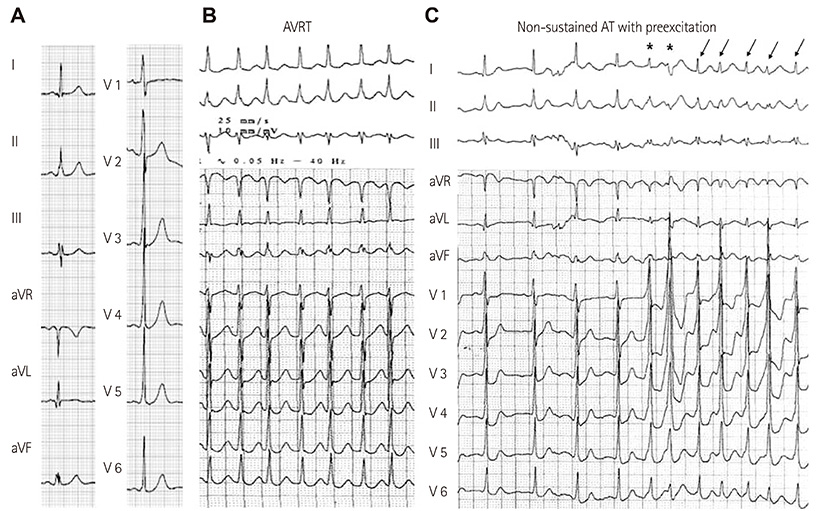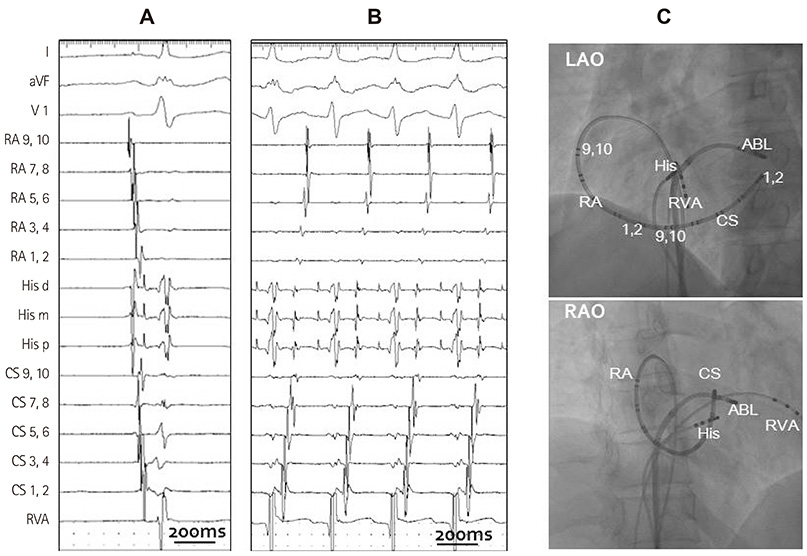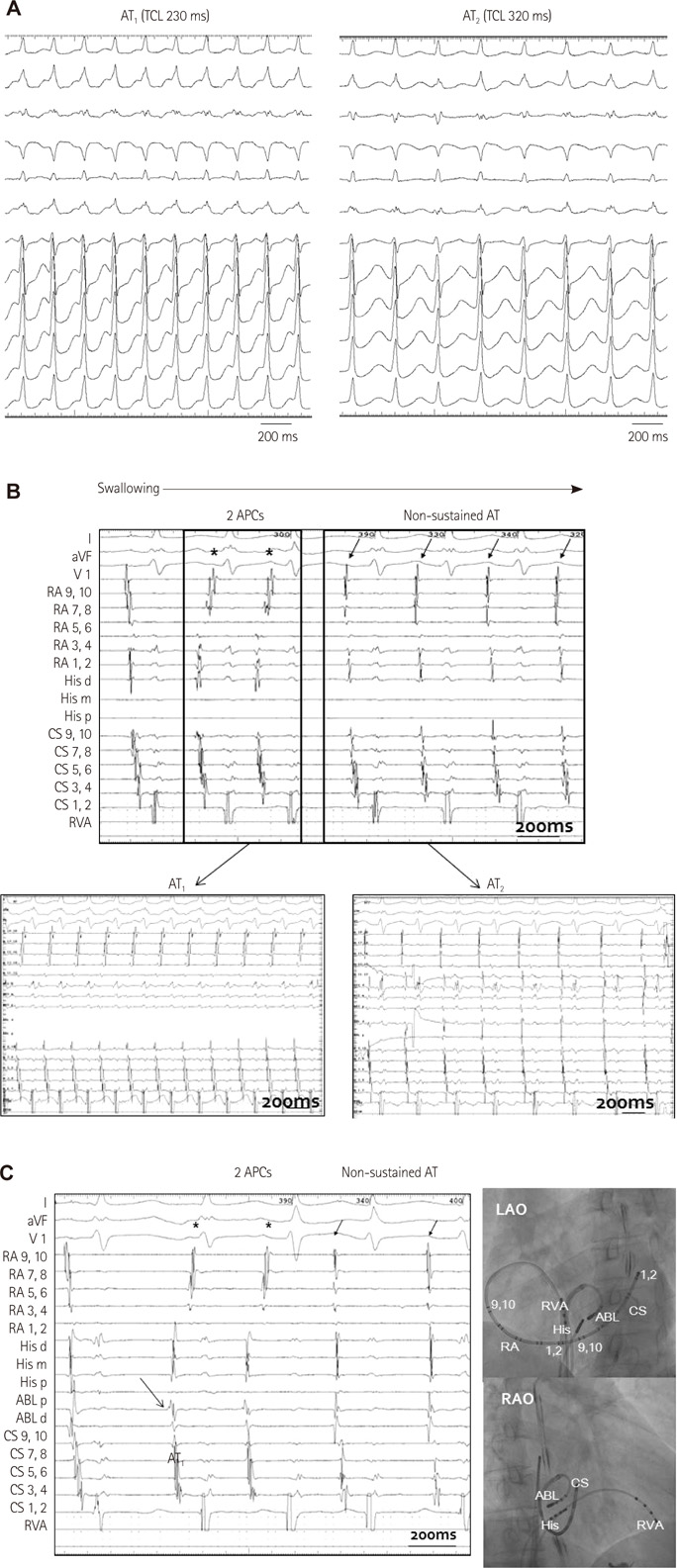Korean Circ J.
2015 May;45(3):253-258. 10.4070/kcj.2015.45.3.253.
Swallowing-Induced Atrial Tachyarrhythmias Successfully Ablated at the Left Posterior Interatrial Septum in Patient with Wolff-Parkinson-White Syndrome
- Affiliations
-
- 1Division of Cardiology, Department of Internal Medicine, Korea University College of Medicine, Seoul, Korea. swparkmd@gmail.com
- KMID: 2389135
- DOI: http://doi.org/10.4070/kcj.2015.45.3.253
Abstract
- We reported a case of a 55-year-old patient who presented with palpitation after swallowing. Initial surface electrocardiogram revealed ventricular preexcitation utilizing a left lateral bypass tract. The orthodromic atrioventricular reentrant tachycardia (AVRT) was induced during electrophysiologic studies. After successful ablation of the AVRT utilizing a left lateral free wall bypass tract, 2 different atrial tachycardias (ATs) were induced under isoproterenol infusion. When the patient swallowed saliva or drank water, 2 consecutive beats of atrial premature complexes (APCs) preceded another non-sustained AT repeatedly, which was coincident with the patient's symptom. The preceding APC couplet had the same activation sequence with one induced AT, and the subsequent non-sustained AT had the same activation sequence with the other induced AT, respectively. We first targeted the preceding 2 consecutive APCs at the left posterior interatrial septum. The following non-sustained AT was also eliminated following ablation of the APCs. After ablation, the patient remained free from the swallowing-induced atrial tachyarrhythmias during the one year follow-up.
Keyword
MeSH Terms
Figure
Reference
-
1. Tada H, Kaseno K, Kubota S, et al. Swallowing-induced atrial tachyarrhythmias: prevalence, characteristics, and the results of the radiofrequency catheter ablation. Pacing Clin Electrophysiol. 2007; 30:1224–1232.2. Greenspon AJ, Volosin KJ. Swallowing-induced tachycardia: electrophysiologic and pharmacologic observations. Pacing Clin Electrophysiol. 1988; 11(11 Pt 1):1566–1570.3. Morady F, Krol RB, Nostrant TT, De Buitleir M, Cline W. Supraventricular tachycardia induced by swallowing: a case report and review of the literature. Pacing Clin Electrophysiol. 1987; 10(1 Pt 1):133–138.4. Matsubara K, Inoue D, Morikawa Y, et al. Swallowing-induced arrhythmia. Clin Cardiol. 1988; 11:798–800.5. Satish OS, Yeh SJ, Yeh KH, et al. Radiofrequency catheter ablation therapy of swallowing-induced atrioventricular nodal reentrant tachycardia: report of two cases. Pacing Clin Electrophysiol. 2005; 28:594–597.6. Yeh SJ, Fu M, Lin FC, Chang CH, Hung JS. Paroxysmal supraventricular tachycardia initiated by a swallowing-induced premature atrial beat. J Electrocardiol. 1986; 19:193–196.7. Baman NS, Baman TS, Taddonio W. Swallowing induced atrial fibrillation. Pacing Clin Electrophysiol. 2004; 27:555–556.8. Yamauchi Y, Aonuma K, Sekiguchi Y, Higuchi K, Obayashi T, Isobe M. Curative therapy for swallowing-induced tachycardia by pulmonary vein antrum isolation. J Cardiovasc Electrophysiol. 2005; 16:1370–1374.9. Yokoshiki H, Mitsuyama H, Watanabe M, Tsutsui H. Swallowing-induced multifocal atrial tachycardia originating from right pulmonary veins. J Electrocardiol. 2011; 44:395.e1–395.e5.10. Undavia M, Sinha S, Mehta D. Radiofrequency ablation of swallowing-induced atrial tachycardia: case report and review of literature. Heart Rhythm. 2006; 3:971–974.11. Nakahara S, Nagashima K, Okumura Y. Proximity relationship between epicardial adipose tissue and the endocardial origin of swallowing-induced atrial tachycardia. Heart Rhythm. 2014; 11:169–170.12. Ardell JL. The cardiac neuronal hierarchy and susceptibility to arrhythmias. Heart Rhythm. 2011; 8:590–591.
- Full Text Links
- Actions
-
Cited
- CITED
-
- Close
- Share
- Similar articles
-
- Left Ventricular Dysfunction and Dilated Cardiomyopathy in Infants and Children with Wolff-Parkinson-White Syndrome in the Absence of Tachyarrhythmias
- Atrial fibrillation in patient with Wolff-Parkinson-White syndrome mimicking ventricular tachycardia
- Spontaneous Transition of Double Tachycardias with Atrial Fusion in a Patient with Wolff-Parkinson-White Syndrome
- Paroxysmal Supraventricular Tachycardia in a Patient with Wolff-Parkinson-White Syndrome Induced by Central Venous Cannulation and Surgical Stimuli during Operation: A case report
- One Case of Cerebral Embolism Associated with Paroxysmal Tachycardia in Wolff-Parkinson-White Syndrome




